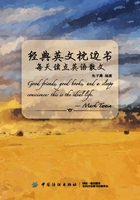
06 生活需要怀抱一颗感恩 之心Enjoy Your Day with Gratitude
Anonymous
A blind boy sat on the steps of a building with a hat by his feet. He held up a sign which said:"I am blind, please help."There were only a few coins in the hat.
A man was walking by. He took a few coins from his pocket and dropped them into the hat.He then took the sign, turned it around, and wrote some words.He put the sign back so that everyone who walked by would see the new words.
Soon the hat began to fill up. A lot more people were giving money to the blind boy.That afternoon the man who had changed the sign came to see how things were.The boy recognized his footsteps and asked,"Were you the one who changed my sign this morning?What did you write?"
The man said,"I only wrote the truth. I said what you said, but in a different way.I wrote:‘Today is a beautiful day, but I cannot see it'."
Both signs told people that the boy was blind. But the first sign simply said the boy was blind.The second sign told people that they were so lucky that they were not blind.Should we be surprised that the second sign was more effective?
佚名
一个双目失明的男孩坐在大楼前的台阶上,脚边放着一顶帽子。他立了一块牌子,上面写着:“我是瞎子,请帮助我。”那帽子里只有寥寥几枚硬币。
一位路人从旁经过,他从口袋里拿出几枚硬币,放在帽子里。然后,他拿起牌子,翻到另一面写了些字。随后他把牌子放回去,让所有路过的人都能看见牌子上新写的字。
很快,帽子里的钱就多起来了。越来越多的人把钱给这个失明的孩子。下午,改写牌子的人回来看看情况,男孩听出了他的脚步声,问道:“您是早上帮我改写牌子的人吗?
您写了什么?”
那人说:“我只是写出了事实。我表达的意思和你一样,只是用了另一种方式。我写的是:‘今天是美好的一天,而我却无法看见。’”
两个牌子都告诉人们男孩是盲人,但第一个牌子只是简单地讲述了这一事实;而第二个牌子却告诉人们,他们是如此幸运,因为他们不是盲人。所以,第二个牌子效果更佳,并没有什么好惊讶的不是吗?
单词解析 Word analysis
gratitude['grætitju:d]n.感激,感谢
例句
I’d like to express my gratitude.
我想表达我的谢意。
blind[blaind]a.瞎的;盲目的
例句
The blind girl died yesterday.
那个失明的小姑娘昨天死了。
coin[kɔin]n.硬币,钱币
例句
He put a coin into the insertion slot.
他往投币孔投入一枚硬币。
fll up填补
例句
Fill up this form, please.
请填好这张表格。
footstep['futstep]n.脚步,脚步声
例句
I heard his footsteps in the hall.
我听见大厅里有他的脚步声。
effective[i'fektiv]a.有效的,生效的;印象深刻的;实际的
例句
Advertising is often the most effective method of promotion.
做广告往往是最有效的推销方法。
语法知识点 Grammar points
本文几乎通篇使用一般过去时。一般过去时表示过去某个时间里发生的动作或状态,也可以表示过去习惯性、经常性的动作、行为。
基本结构:主语+动词过去式+其他
否定形式:①was/were+not
②在行为动词前加didn't,同时还原行为动词。
一般疑问句:Did+主语+do+其他
例句
A blind boy sat on the steps of a building with a hat by his feet.
一个双目失明的男孩坐在大楼前的台阶上,脚边放着一顶帽子。
He held up a sign which said:"I am blind, please help."
他立了一块牌子,上面写着:“我是瞎子,请帮助我。”
There were only a few coins in the hat.
那帽子里只有寥寥几枚硬币。
A man was walking by.
一个路人从旁经过。
Were you the one who changed my sign this morning?What did you write?
您是早上帮我改写牌子的人吗?您写了什么?
经典名句 Famous classic
1."I only wrote the truth. I said what you said, but in a different way.I wrote:‘Today is a beautiful day, but I cannot see it'."
“我只是写出了事实。我表达的意思和你一样,只是用了另一种方式。我写的是:‘今天是美好的一天,而我却无法看见。’”
2.Both signs told people that the boy was blind.But the first sign simply said the boy was blind.The second sign told people that they were so lucky that they were not blind.
两个牌子都告诉人们男孩是盲人,但第一个牌子只是简单地讲述了这一事实;而第二个牌子却告诉人们,他们是如此幸运,因为他们不是盲人。
名人名言 Quotations From Famous People
Problems are not stop signs, they are guidelines.
—Robert H. Schuller
——罗伯特·舒勒
In despair there are the most intense enjoyments, especially when one is very acutely conscious of the hopelessness of one's position.
—Fyodor Dostoevsky
——陀思妥耶夫斯基